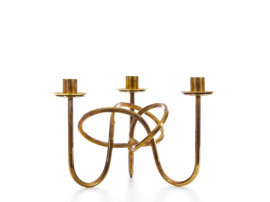
Svenskt Tenn,
Stockholm-based interiors firm and design production house Svenskt Tenn was founded in 1924 by 30-year-old art teacher Estrid Ericson. Inspired by the English Arts & Crafts movement and using a small inheritance from her father as seed money, Ericson hoped to capitalize on the trendiness of modern pewter objects in Sweden at the time. Partnering with pewter artist Nils Fougstedt, she began to produce an array of pewter collections in a small workshop behind their storefront. The brand, which translates to “Swedish Tin,” quickly established a reputation for quality and fashionable taste. In 1925, Svenskt Tenn received a gold medal at the Exposition Internationale des Arts Décoratifs et Industriels Modernes in Paris.
By the end of the 1920s, Ericson was regularly taking on commissions to create interior designs, and the company moved to a larger location on the prestigious Strandvägen Boulevard—where it’s still located today. As Svenskt Tenn’s business continued to grow in the 1930s, Ericson began to collaborate with outside designers, such as Uno Åhrén and Björn Trägårdh, to create new furniture collections, while also traveling around the world for inspiration and client cultivation.
Around 1934, Ericson began her most famous collaboration with Austrian architect-designer Josef Frank. Frank had been an active, pioneering proponent of modernist architectural theory in Vienna; though always taking a more “humanist” approach to its aesthetic expression. As the Nazis’ power increased, he was forced to flee his homeland. Ericson offered Frank a safe haven in Stockholm and hired him as Svenskt Tenn’s Head Designer. Working together for decades, Ericson and Frank departed from relatively rigid Scandinavian functionalism for what became the company’s signature style—a vivid (often patterned), simple yet sophisticated aesthetic, which was applied to a variety of product designs, including furniture, lighting, wallpaper, and textiles, as well as pieces specially commissioned for private interiors all over the world. Some of these are still in production today.
Through major exhibitions in Paris, New York, and San Francisco in the years before World War II, Josef Frank’s designs for Svenskt Tenn created an international obsession with the “Swedish Modern” aesthetic. Blending the pared-back simplicity of functionalism with the organic patterning of Arts & Crafts and the decorative detailing of Art Deco, Frank produced designs in brass, fine wood, rattan, bamboo, and more. Today, he is considered an icon of a softer, more liveable take on modernism.
Estrid Ericson ran Svenskt Tenn’s daily operations until 1975 when, at the ago of 81, she sold her company to the Kjell & Märta Beijer Foundation. In 1979, Ann Wall was appointed the new managing director and ran the company till the end of the century. Today there is a national design prize named in Wall’s honor.
Source : Pamono

